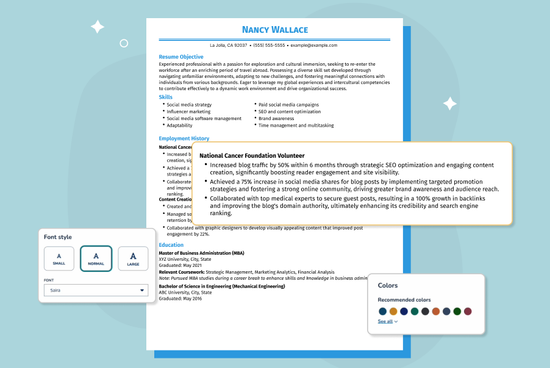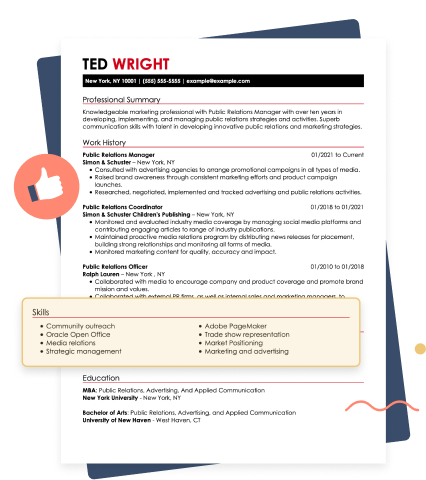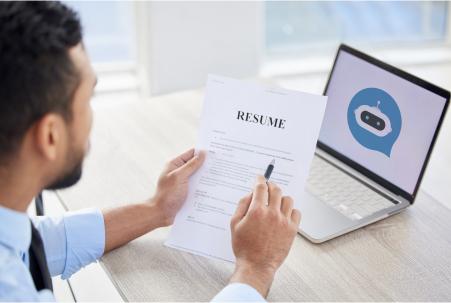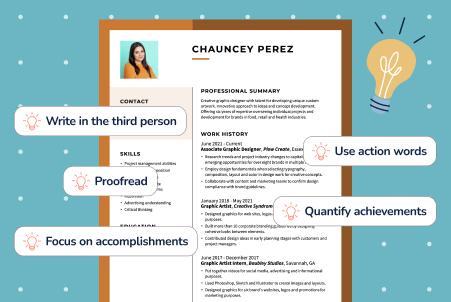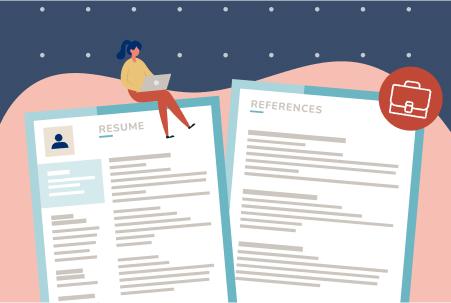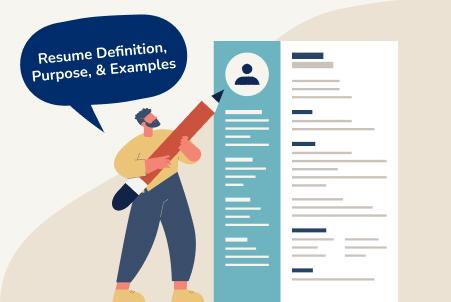How to Explain an Employment Gap on Your Resume

Our customers have been hired at: *Foot Note
Whether you took time off to care for a family member, pursue further education, or navigate a career transition, having employment gaps on your resume shouldn't deter you from pursuing your dream role.
In this article, we'll cover how to explain gaps in employment on your resume with some examples. You'll also find helpful tips for addressing those in a cover letter and interview so you can confidently jump into job searching.
Jump to the following sections:
What Are Employment Gaps?
Employment gaps on a resume refer to periods where an individual was not employed or had a break in their work history. Employment gaps can occur for various reasons, such as taking time off to travel, raising a family, pursuing further education, or being unemployed.
Potential employers understand that life circumstances and personal pursuits can lead to employment gaps. Still, they will want to know how you utilized that time. They will often choose candidates who remained engaged in personal or professional development. Explore our career gaps report for key insights and data.
Why it’s important to address employment gaps
It’s always best to be transparent about an employment gap in your resume. Leaving resume gaps unexplained can raise red flags for employers, leading them to question your commitment or reliability.
By proactively explaining your employment gap, you can demonstrate your dedication to your chosen field and your ability to overcome challenges.
Moreover, it’s an opportunity to highlight skills and educational experiences you gained during that time and turn these periods into valuable assets that set you apart from other candidates.
A recent survey shows that 64.2% of job applicants admit to lying on their resumes, with 81.4% of those applicants getting caught. More than 35% of those cases have had their offers withdrawn, while others were fined.
The lesson? Be honest about your job history, even if that means having employment gaps on your resume.
Steps for Explaining Gaps in Employment
While it may seem challenging, addressing employment gaps can be straightforward. Follow these steps to ensure you maximize the opportunity to show your commitment to professional development:
STEP 1
Decide if it’s necessary to display your employment gap
The first step in addressing an employment gap is to decide if it belongs on your resume. Your resume should be two pages at most and cover the last 10 years of your career.
If your employment gap happened early in your career or lasted only a month or so, you may omit it from your resume and focus on your most recent and job-relevant positions.
However, if your employment gaps happened more recently in your career or were long gaps, you should account for them in your resume.
STEP 2
Choose the right resume format
Your resume format can be an excellent tool for effectively framing gaps in resumes.
Professionals with lengthy employment gaps should opt for a functional resume format to emphasize their professional skills and achievements over their employment history.
Our resume examples library has hundreds of functional resumes to help you create your own. Choose one and customize it in our Resume Builder.
STEP 3
Fill in the gaps
Be honest. Explain what you were doing during each employment gap, whether it was a personal project or achievement that shows your passion and drive, volunteer work that displays your desire to help others, or professional training that helped prepare you for your next role.
For example, if you used your time for a community service project, you could add it to your work history like this:
Food Pantry Creator and Manager
6/2021 - 10/2022
- Created, managed and organized a neighborhood pantry that provided food for 350+ people per week.
- Recruited and trained volunteers in food collection, organization and distribution.
- Managed a team of 10 regular volunteers.
Or if you took some time off to raise your children, your employment gap might look like this:
Stay-at-Home Parent
2020 - 2025
- Raised my four small children and managed the household.
STEP 4
Highlight transferable skills
Show potential employers that you learned valuable job-relevant skills during your employment gap. One way to do this is to highlight the transferable skills you picked up during a personal project, freelance work, or while traveling abroad.
For example, you can create a dedicated section on your resume called “Core Competencies” to spotlight your transferable skills, like this:
Core Competencies
- Problem-solving
- Collaboration
- Active listening
- Leadership
- Creativity
- Research
How to Write an Employment Gap on Your Resume
The key to explaining gaps in your resume is addressing them head-on and using your strong writing skills to spin it positively. Here's how to explain employment gaps when writing your resume:
In your professional summary or resume objective
Suppose you took time off to raise a family, focus on an entrepreneurial venture, go back to school, or travel. In that case, you can briefly mention it in your professional summary or objective.
For example:
In your skills section
In addition to listing your essential hard and soft skills, you can create a separate skills section titled "Core Competencies" or "Key Qualifications," where you include the skills gained during your employment gap.
For example, suppose you spent a year developing a community outreach program. In that case, you might add a separate skills section like this:
Key qualifications:
- Entrepreneurial mindset: Proven ability to identify opportunities, take calculated risks, and drive business growth through innovative strategies.
- Strategic planning: Experience developing and executing business plans, setting goals, and implementing effective strategies to achieve objectives.
- Leadership: Demonstrated leadership skills in managing teams, fostering collaboration, and inspiring others to achieve common goals.
- Problem-solving: Proficient in identifying challenges, analyzing root causes, and implementing solutions to overcome obstacles and drive success.
- Adaptability: Ability to thrive in dynamic environments, pivot quickly in response to changing circumstances, and embrace new challenges with resilience.
In your employment history
Chances are, the employment gap on your resume will be obvious in your work history section, so treat it like a job.
If you used the time away from work to volunteer, you can add your volunteer experience in the same format as in your past job roles like this:
Jan. 2020 - March 2021
- Increased blog traffic by 50% within 6 months through strategic SEO optimization and engaging content creation, significantly boosting reader engagement and site visibility.
- Achieved a 75% increase in social media shares for blog posts by implementing targeted promotion strategies and fostering a strong online community, driving greater brand awareness and audience reach.
- Collaborated with top medical experts to secure guest posts, resulting in a 100% growth in backlinks and improving the blog's domain authority, ultimately enhancing its credibility and search engine ranking.
In your educational background
When addressing employment gaps in the education section of your resume, highlight the value and relevance of the experiences you undertook during that time.
One approach is to list any relevant courses, certifications, workshops, or training programs completed during the gap period. This demonstrates a commitment to continuous learning and skill development.
For example:
Education
Master of Business Administration (MBA)
XYZ University, City, State
Graduated: May 2021
Relevant Coursework: Strategic Management, Marketing Analytics, Financial Analysis
Note: Pursued MBA studies during a career break to enhance skills and knowledge in business administration.
Bachelor of Science in Engineering (Mechanical Engineering)
ABC University, City, State
Graduated: May 2016
In the above example, the job seeker has used their education section to address employment gaps by including relevant coursework completed during their MBA studies.
By mentioning that they pursued their MBA during a career break, they provide context for the gap in their employment history and highlight their commitment to professional development.
Addressing Employment Gaps in Your Cover Letter
Addressing employment gaps in a cover letter requires a tactful approach that highlights your strengths and explains the reasons behind the gap in a positive light.
Here are seven tips for explaining employment gaps in your cover letter:
- Be transparent: Avoid being defensive or providing unnecessary details. Employers appreciate honesty, so be straightforward about the reasons for the gap.
- Provide context: Whether it was due to personal reasons, career transition, further education, caregiving responsibilities, or voluntary work, offer a concise explanation that puts the gap into context.
- Highlight relevant activities: Emphasize any relevant activities you pursued during the gap, such as freelance work, consulting projects, volunteer work, professional development courses, or personal projects. Focus on how these experiences helped you develop skills or gain insights that apply to the position.
- Emphasize your transferable skills: Explain how the transferable skills you gained during the gap make you a strong candidate for the position and demonstrate your adaptability.
- Focus on the positive: The cover letter should focus on your enthusiasm for the role and your eagerness to contribute to the company's success.
- Demonstrate readiness to return: Assure the employer that you are fully prepared to re-enter the workforce and are committed to making a meaningful contribution.
- Customize your cover letter for each application: Tailor your explanation of the employment gap to each specific job application.
Discussing Employment Gaps in an Interview
Addressing employment gaps in a job interview requires honesty, confidence, and an emphasis on how you used that time to grow personally and professionally.
Here are seven ways to address employment gaps effectively during a job interview:
- Be prepared: Anticipate questions about your employment history and be ready to address any gaps.
- Be honest: Whether it was due to personal reasons, further education, travel, caregiving responsibilities, or a career transition, be transparent about it.
- Focus on the positive: Highlight any new skills you acquired, certifications you earned, volunteer work you did, or personal projects you pursued. Show how you used the time to develop yourself personally and professionally.
- Show initiative: Demonstrate that you were proactive during the gap period. Discuss any steps you took to stay connected to your industry, such as attending networking events, taking online courses, or participating in relevant projects.
- Stay confident: Avoid appearing defensive or apologetic about the gap. Instead, focus on conveying your enthusiasm for the opportunity and readiness to contribute to the organization.
- Practice responses: Before you answer questions about your employment gap, practice answering them with a friend or family member to ensure your responses are clear, concise, and positive.
- Redirect the conversation: If the interviewer seems overly focused on the employment gap, redirect the conversation to your qualifications, skills and achievements relevant to the job.
Key Takeaways
- Whether it was due to personal reasons, further education, or a period of unemployment, being transparent about the circumstances will help build trust with potential employers.
- A functional resume can help you effectively frame your employment gap while showcasing your strengths.
- Highlighting experiences like volunteering, freelancing, online courses, or professional development shows your commitment to continuous learning and growth.
- Consider utilizing resume sections like your professional summary and educational background to further explain your employment gap.
- Emphasize the skills and knowledge you acquired during the employment gap.
- Use your cover letter to briefly explain the employment gap and how you used that time to enhance your skills and knowledge. This can provide context for potential employers and show that you proactively address their concerns.
- When preparing for your interview, practice explaining the reasons for the gap and how you used that time to grow personally and professionally. Showing self-awareness and a positive attitude towards the gap can help alleviate employers' concerns.
FAQ
Should I include the dates of employment gaps on my resume?
Including the dates of employment gaps is not necessary. Instead, highlight your skills, achievements and relevant experiences during employment gaps.
How can I explain employment gaps during an interview?
When explaining employment gaps during an interview, be honest and transparent. Highlight any personal or professional development activities you pursued during that time, and emphasize your readiness and enthusiasm to re-enter the workforce.
Can I use a functional resume format to downplay employment gaps?
Using a functional resume format can be an effective way to downplay employment gaps. This format allows you to highlight your skills and achievements rather than focus on your work history’s chronological order.
Should I mention employment gaps in my cover letter?
Yes. If your employment gap is lengthy, a cover letter is an excellent opportunity to explain it and refocus the attention on what you can bring to the company and the qualifications that make you an ideal candidate.
Can I use a combination resume format to address employment gaps?
Yes, a combination resume format can be a great option to address employment gaps. This format lets you highlight your skills and work experience, providing a comprehensive overview of your qualifications.
Should I include a section explaining employment gaps on my resume?
Including a section explaining employment gaps on your resume is not necessary. Instead weave your employment gap into your standard resume sections while showcasing your skills, achievements, and relevant experiences that make you a strong candidate for the position.
How can I make my employment gaps appear more positive on my resume?
Focus on the skills and experiences gained during that time to make your employment gaps appear more positive. Highlight any freelance work, volunteering, or relevant courses you undertook, demonstrating your commitment to continuous learning and professional growth.
Can I use a professional summary to address employment gaps?
Yes, a professional summary can be an effective way to address employment gaps. Use this section to highlight your key qualifications, skills and achievements, showcasing transferable skills, such as communication, leadership and problem-solving.
How we reviewed this article
Since 2012, we have helped more than 11 million job seekers. We want to make your career journey accessible and manageable through our services and Career Center’s how-to guides and tips. In our commitment to bring you a transparent process, we present our Editorial Process.
Sources
- Career Confidential. Article. Don’t be Tempted to Lie About Resume Gaps
- HRO Today. Article. Over Half of Employees Report Lying on Resumes
- Harvard Business Review. Revzin, Sergei. Revzin, Vadim.How to Fill an Employment Gap on Your Resume
Our customers have been hired at:*Foot Note
